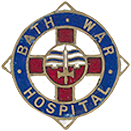The Bath War Hospital: An Introduction


When the First World War started in August 1914 most people thought it would be over by Christmas, but by the early months of 1915 the increasing ferocity of the fighting and the growing number of casualties meant that better preparations need to be made to treat the injured soldiers. Several military hospitals already existed, and even before the outbreak of war a number of hospitals had been identified for military use; a few days after war was declared the Bristol Royal Infirmary and Southmead Hospital were handed over to the War Office for the use of the army. Owners of large country houses all over the country offered them to the army, but in general these were only suitable for use as convalescent homes, very often for officers only. One local example was Newton Park (now Bath Spa University), which became the Countess Temple Hospital for Wounded Soldiers, and the sanatorium at Kingswood School provided 15 beds.
However, casualty fi gures continued to mount, and in May 1915 the Mayor of Bath, Frederick Spear, received a telegram from the War Office urgently appealing for hospital accommodation for the wounded from overseas. The Mayor immediately promised 150 beds at the Royal United Hospital (then still situated in the centre of the city), and then, after further discussions, it was decided that the City of Bath would provide 500 beds at a hospital to be built on empty fields at Combe Park. Sir Alfred Keogh, the Deputy Director General of the Army Medical Service, was greatly in favour of Bath as a place for a military hospital because of ‘its nearness to Southampton, its two railways, and the advantage of its mineral springs’. He also stated that ‘there was no town the size of Bath with a larger body of resident medical men, physicians and surgeons – the greatest need of all – and this had been a great difficulty in a lot of the smaller hospitals in smaller places’. Bath’s long history of medicine was about to enter a new phase.
gures continued to mount, and in May 1915 the Mayor of Bath, Frederick Spear, received a telegram from the War Office urgently appealing for hospital accommodation for the wounded from overseas. The Mayor immediately promised 150 beds at the Royal United Hospital (then still situated in the centre of the city), and then, after further discussions, it was decided that the City of Bath would provide 500 beds at a hospital to be built on empty fields at Combe Park. Sir Alfred Keogh, the Deputy Director General of the Army Medical Service, was greatly in favour of Bath as a place for a military hospital because of ‘its nearness to Southampton, its two railways, and the advantage of its mineral springs’. He also stated that ‘there was no town the size of Bath with a larger body of resident medical men, physicians and surgeons – the greatest need of all – and this had been a great difficulty in a lot of the smaller hospitals in smaller places’. Bath’s long history of medicine was about to enter a new phase.
It must be remembered that the National Health Service did not exist at this time, so this was a huge undertaking. The War Office paid for the buildings and some of the equipment, and paid an allowance of 3 shillings per day for each occupied bed: the rest of the funding would have to c ome from donations made by the public. The Mayor raised a committee that consisted of representatives from Bath’s two hospitals, the Red Cross Society, the St. John’s Ambulance Assoc
ome from donations made by the public. The Mayor raised a committee that consisted of representatives from Bath’s two hospitals, the Red Cross Society, the St. John’s Ambulance Assoc
iation and other interested parties. The committee agreed to fund the operating room and X-ray department, and to furnish the nurses quarters. With these terms agreed the Bath Chronicle announced a public meeting to be held at the Guildhall on Friday 27th October, and it was hoped that ‘all those interested in the care of our wounded soldiers will make an effort to attend’. The fund raising began, and the first hospital at Combe Park was established.
Unfortunately, all the records of the War Hospital were sent as salvage during the Second World War, but by using reports from the Bath Chronicle and other sources it has been possible to build a picture of life at the hospital, and its relationship with the wider City of Bath.
